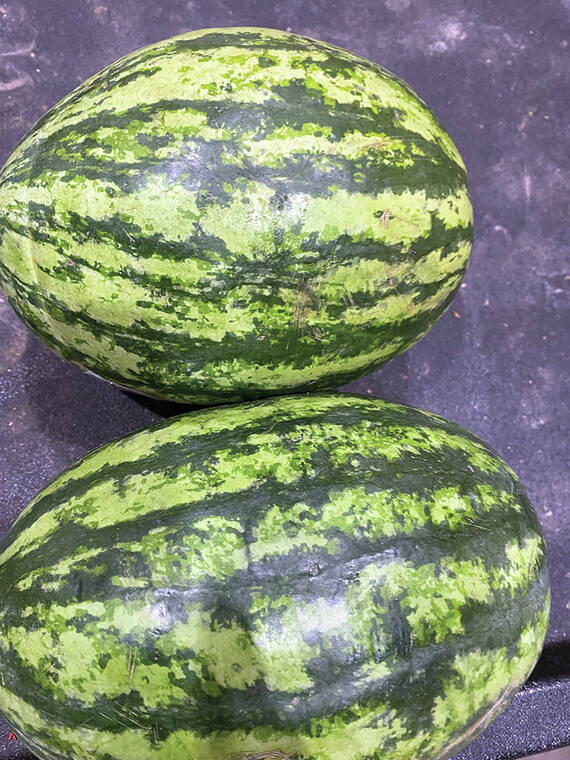Let’s Talk Food: Watermelons are in season

Photo courtesy Audrey Wilson Watermelons are one of those perfect foods, healthy, with no fat or cholesterol.
Summer means many fruits and vegetables are in season and a great time to enjoy them.
Summer means many fruits and vegetables are in season and a great time to enjoy them.
Watermelon is one such vegetable. Yes, a vegetable and not a fruit as we may all think.
ADVERTISING
Some of the sweetest local ones are coming from Ewa and Aloun Farms, where it is very warm and dry.
Seedless watermelons are what is usually available and they are self-sterile hybrids that develop normal looking fruits with no fully developed seeds. According to the University of Illinois Extension Service, “The seeds for growing them are produced by crossing a normal diploid watermelon with one that has been changed genetically into a tetraploid one. The seeds from this cross produce plants that, when pollinated by normal plants, seedless melons.
“In seedless watermelons (genetic triploids), rudimentary seed structures form but remain small, soft, white, tasteless and undeveloped tiny seedcoats that are eaten virtually undetected along with the flesh of the melon. Seed production for these seedless types is an extremely labor intensive process that makes the seeds relatively expensive. Because germination of these types is often less vigorous than normal types, it is recommended that they be started in peat pots or other transplantable containers, where the germinating conditions can be closely controlled. Once transplanted, cultivation is similar to that for regular watermelon.”
So you can see that the convenience of having no seeds is a process so we should not moan when we have to pay $1.30 a pound for it.
There are many varieties of watermelon and I am not sure which ones are available to us at the market.
Early harvest ones include Golden Crown which has red flesh, green skin, with the skin turning yellow when ripe; Sugar Baby with red flesh and weighing 6 to 10 pounds; Yellow Baby with a hybrid yellow flesh at 6 to 10 pounds; and Yellow Doll, another yellow hybrid, growing 6 to 10 pounds.
The main harvest varieties, taking 80 to 85 days to grow, are Charleston Gray, a red melon at 20 to 25 pounds; Crimson Sweet, a red at 20 to 25 pounds; Madera, a hybrid red at 14 to 22 pounds; Parker, another hybrid red at 22 to 25 pounds; Sangria, a hybrid red at 22 to 25 pounds; Sunny’s Pride, a hybrid red at 22 to 25 pounds; and Sweet Favorite, a hybrid red at 20 pounds.
Seedless varieties, which are all triploid hybrids, taking 80 to 85 days till harvest, include Cotton Candy, a red at 15 to 20 pounds; Crimson Trio, a red at 14 to 18 pounds; Honey Heart, with yellow flesh, 8 to 10 pounds; Jack of Heart, red, 14 to 18 pounds; Nova, red at 15 to 17 pounds; Queen of Hearts, red, 12 to 16 pounds; and Tiffany, red, at 14 to 22 pounds.
Choosing a good watermelon is tricky. You can take that heavy melon home and then see after you chose the right one after cutting it open. Here are some thoughts of choosing the right one:
• Look for the “ripe spot.” It is on the bottom of the watermelon and is a light yellow or creamy color. This spot develops as the lemon grows on the soil. It the spot is greenish or white is color, it is not ripe yet. They do not continue to ripen once picked, so it is important to look for the light yellow spot.
• The outside rind should be firm and hard, blemish free. The green color should be dull and not light or bright green. If you feel soft spots, it is starting to turn bad.
• Choose one with a symmetrical shape, mice oval or round.
• Lift the watermelon, it should be good and heavy, as it contains 90% water.
Enjoy watermelons while in season! They are one of those perfect foods, healthy, with no fat or cholesterol. They are high in lycopene, second only to tomatoes. Research shows that lycopene, a powerful antioxidant, is effective in preventing some forms of cancer and cardiovascular disease.
A University of North Carolina at Chapel Hill study found that men who consumed a lycopene-rich diet were half as likely to suffer a heart attack as those who had little or no lycopene in their diets.
Watermelon is high in vitamin C and vitamin A, in the form of beta-carotene. Some research suggests that the red pigmented food are disease fighters. Lycopene and beta-carotene work in conjunction with other plant chemicals not found in vitamin/mineral supplements. One wedge, or 1-2/3 cups, of watermelon has 91 calories, 1.77 grams of protein; 1.43 grams of dietary fiber; 331 grams of potassium, 27 mg of vitamin C and 1,046 IU of vitamin A.
When you get home, wash your whole watermelon with water before slicing it to remove potential bacteria.
Watermelons make great summer salads with a combination of olives and feta cheese.
Email Audrey Wilson at audreywilson808@gmail.com.


